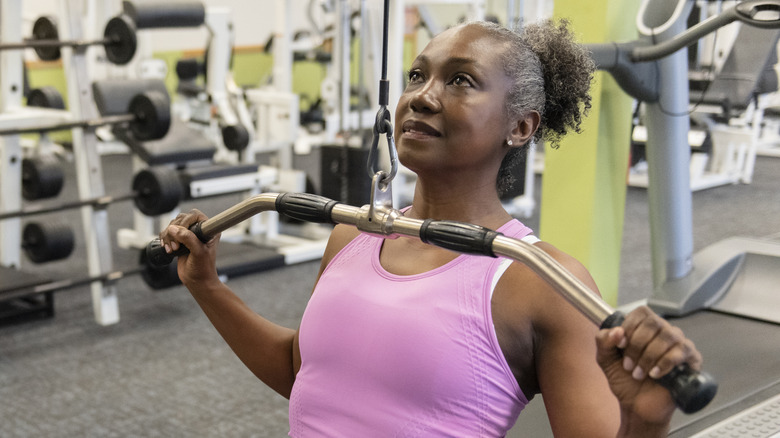When Men And Women Over 50 Don't Lift Weights, This Is What Happens
Lifting weights often evokes the stereotype of a bulky guy in a tank top walking around the gym lugging a gallon of water. So, rather than queue up at the squat rack, many people instead opt for the treadmill or elliptical to get in their 150 minutes of moderate exercise each week. However, a dedicated strength training program can improve your health in many ways.
Endurance enthusiasts like runners might find that strength training twice a week will help them run faster and prevent injury. A little more added muscle will fire up your metabolism to help you lose weight, too. And, men and women over 50 will benefit from strength training to improve their balance and prevent falls later in life. That's because older adults are at risk for osteoporosis if they don't lift weights.
Osteoporosis makes your bones more susceptible to fractures during everyday stressors. For example, you could break a bone in your foot if you lose your footing while stepping off a curb. Even situations like coughing or bending over could cause a fracture if you have osteoporosis.
Muscle loss is linked to osteoporosis
Beginning at the age of 30, you start to lose between 3% and 8% of muscle every decade, depending on your level of activity, diet, and lifestyle, according to a 2004 article in Current Opinion in Clinical Nutrition and Metabolic Care. This muscle loss begins to escalate as you age, particularly after age 60. Women might also notice losing more muscle during menopause as they lose estrogen. Some people develop sarcopenia, which is a condition where people lose muscle at a faster rate than others.
A 2018 review in European Geriatric Medicine found that sarcopenia is closely linked with osteoporosis. People with both weak bones and muscles have lower bone density, which can further increase the risk of breaking a bone during a fall.
Lifting weights not only builds muscle but also puts stress on your bones to prevent osteoporosis. Muscles adapt to the stress of strength training by building more muscle fibers. Bones also become stronger when you regularly submit them to the controlled impact of weight training. A 2016 study in the European Journal of Endocrinology had 37 women with weak muscles take part in a strength training program three times a week for 16 weeks. While the program built bone density in their hips, this improvement went away once they stopped the weight training program.
Exercises that improve bone health
Pilates might improve your posture and stretch your spine, but it's probably not the best exercise to improve your bone health. The American Academy of Orthopaedic Surgeons says you'll need to include exercises that impact your muscles and bones. Strength training and weight-bearing exercises like walking, dancing, and pickleball keep your muscles and bones working to protect against age-related bone loss. The Centers for Disease Control and Prevention (CDC) suggests 150 minutes of moderate exercise per week, so you can include any weight-bearing exercises to boost heart, muscle, and bone health. If you're into running or another vigorous activity, you'll only need 75 minutes.
Adults over 65 also need to incorporate at least two days of strength training, whether it's free weights, machines, medicine balls, resistance bands, or bodyweight exercises. The Royal Osteoporosis Society says to include hinge, push, pull, and squat exercises in your strength training program. Bridges and deadlifts are considered hinge movements. The CDC also encourages adding some balance exercises like walking backward or working with a balance board. Some types of yoga can work on your balance, strength, and cardio health.



